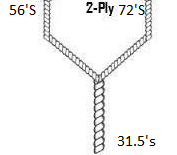Yarn Count:
Count is a number of indicating the mass per unit length or length per unit mass of yarn.
Yarn Count is defined as the weight per unit length of the yarn or the length per unit weight.
Yarn Count System:
There are several count system of yarn. These count systems have been divided in two ways.
- Indirect system
- Direct System
Indirect Count System:
The length of a fixed weight of yarn is measured. The length per unit weight is the yarn count.
Example: Ne ( English Cotton Count), Nm (Metric Count) etc.
The common features of all the indirect count systems are the weight of the yarn is fixed and the length of the yarn varies according to its fineness.
The following formula is used to calculate Indirect count:
N = (L×w) / (W×l)
Where,
N =Yarn count ( Indirect)
W =Weight of the sample
L=Length of the sample
l=Unit of length of the sample
w = Unit of weight of the sample.
Below is one example for easy understanding .
If L= 9800 m
W= 490 gm
w=1 lb=453.6 gm
l=840yds=840×0.91 m
So, Ne = (9800×453.6)/(490x840x0.91)
Ne=11.87 ( means 12 Ne)

In Brief, the definition of the above systems is as follows:
- Ne, English Count : No. of 840 yds lengths per pound
- Nm, Metric Count : No Kilometers per Kgs
- YSW, Woolen Count : No. of 256 yds lengths per pound
- NeL, Linen Count : No. of 300 yds lengths per pound
For Example: 30 Ne means 30 Hanks of 840 yds( 30X840 yds) length yarn weight is 1 pound.
Direct Count System:
The weight of a fixed length of yarn is determined. The weight per unit length is the yarn count.
Example: Tt (Tex), D (Denier), Dtex ( Decitex) etc.
The common features of all direct count systems are the length of yarn is fixed and the weight of the yarn varies according to its fineness.
The following formula is used to calculate Indirect count:
N= (W×l) / L
Where,
N =Yarn count ( Direct)
W =Weight of the sample
L=Length of the sample
l=Unit of length of the sample
for example,
If L= 9800 m
W= 490 gm
l=1000 m
So, Tex= (490×1000)/9800
=50 Tex

In Brief, the definition of the above systems is as follows:
- Tex, Tex Count : No. of grams per 1000 metres
- D, Denier : No. of grams per 9000 metres
- Dtex, Decitex : No. of grams per 10,000 metres
- mtex, Militex : No. of miligrams per 1000 metres
- ktex, Kilotex : No. of Kilogram per 1000 metres
- Jute count : No. of lbs per 14400 yds
For Example: 50 Tex means 1000 meters of yarn weight is 50 gms.
Yarn Count Conversion :
It is very easy to convert yarn count from one system to another by remebering only one line formula from below table.

Suppose you wanted to convert 50 Tex to Ne.
We Know,
Tex= (590.6/Ne),
50=(590.6/Ne)
Ne=590.6/50
Ne=11.81 ( So, 12 Ne)
Count Calculation for Ply or Double Yarn ( For Same count Yarn Making Ply):
Calculation of count on Indirect System:
Nr = N/n
Where ,
Nr= Ply of resultant Count
N= Single Yarn Count
n= Number of yarn in the ply

Calculation of count on Direct System:
Nr = N x n
Where ,
Nr= Ply of resultant Count
N= Single Yarn Count
n= Number of yarn in the ply

If the Yarn of different Count Plied together , then the formula will be as below…..
Count Calculation for Ply or Double Yarn ( For different yarn count Yarn Making Ply):
Calculation of count on Indirect System:
1/Nr = 1/N1 + 1/N2
Where ,
Nr= Ply of resultant Count
N1= 1st Single Yarn Count
N2= 2nd Single Yarn Count

Calculation of count on Direct System:
Nr = N1 + N2
Where ,
Nr= Ply of resultant Count
N1= 1st Single Yarn Count
N2= 2nd Single Yarn Count

Which Yarn is finer ?
Indirect System:
- Higher count yarn is thinner than lower count yarn

Direct System:
- Higher count yarn is thicker than lower count yarn


